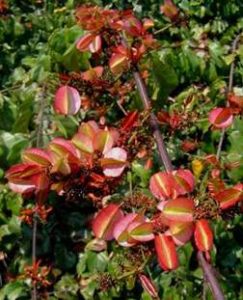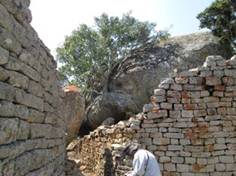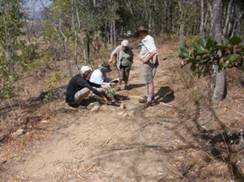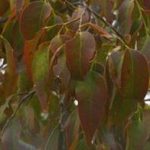TREE LIFE
September 2018
MASHONALAND CALENDAR
Saturday September 1st: Botanic Garden walk. This is the loveliest month of the year so come and walk in this beautiful garden. Meet in the car park at 0830 hours. The walk usually lasts for 1.5 hours.
Sunday September 16th: We are going to be visiting Thetford Game Reserve again. This is a really lovely venue and it should be looking wonderful at this time of year. For those wanting to share lifts meet at CABS parking area off Ridgeway North at 0830 hours for 0845 hours take off. Bring your usual picnic lunch, cooler box, chair, hat, sun block etc. and enjoy a very good day out.
Directions: From Harare head North on the Mazowe road, A11. Turn right 6km after the road toll on to Christon Bank Road. After 6km turn right. This tar road turns to dirt for 4km. Turn left 350m after Mazowe River Bridge onto tar road to Thetford. Meet at Thetford at 0930 hours. There is a $10 per person entrance fee payable by cash or eco-cash.
Saturday September 22nd: We are going to explore the Prince Edward School Arboretum
BOTANIC GARDEN WALK SATURDAY JUNE 2ND 2018
I arrived at the National Botanic Gardens on the beautiful morning of Saturday, June 2 to find not another soul in sight. A few minutes later, Meg Coates Palgrave arrived, and she too was bemused by the absence of botanists. After a 10-minute wait we decided to proceed, just the two of us, focussing on the Zambezi Valley-Save Limpopo Valley section of the gardens. The first things to catch Meg’s eye were the silvery leaves of Combretum imberbe. She showed me how the scales on this tree’s leaves are visible to the naked eye on both sides of the leaf, and not just on the underside, as is the case with other combretums.
A little further on I showed Meg the Blue Cat’s Whiskers (Clerodendrum myricoides) that I’d seen flowering earlier in the year. The fruits had been polished off by birds, but Meg picked a leaf and showed me how the leaf runs down almost the entire length of the petiole and has a serrated margin. Crushed between the fingers it has a distinctive smell too.

Commiphora mollis in full leaf. Photo: Ryan Truscott
Acacia eriocarpa was our next stop, and its pods our focus of interest. I had taken pictures of this particular tree in flower on a society outing earlier in the year, so it was interesting now to examine the fruit. It was at this point that we were joined by Sarah Roberts and Hunter, her Jack Russell.
We congregated around a small tree with large maple-like leaves. Meg made me chew one. After a while it became slimy (botanists call it mucilaginous) and it’s a distinctive feature of this tree – the Zambezi Oak. “A lovely name,” commented Sarah. And it is a lovely tree too, though this one was a fairly small specimen. The Zambezi Oak, or Triplochiton zambesiacus grows very big in the wild. Meg recalled how when she was a guide at Bumi she would stop her vehicle under a large Zambezi Oak and let her children sample the leaves, just as I had. She says when fried the leaves make good sun downer snacks.
Close to the Zambezi Oak was a small tree with leaves in distinctive whorls of three, with a rounded tip at their centre. “Gardenia resiniflua,” declared Meg, and there, on closer inspection, were the tiny tell-tale gardenia fruit. The tree (commonly known as the Gummy Gardenia) gets its specific name from the resin exuded on the growing tip when it comes into leaf in the hot dry areas where it’s usually found. Meg says that’s because the leaves open before the rains and need the lubrication to help them emerge. The sunken veins on the upper surface of the leaves give them a puckered look and distinguish this tree from other gardenia species.

Balanites maughamii. Showing bi-foliolate leaves and Y-shaped thorns. Photo: Ryan Trusco
Next up was a large tree with a multi-stemmed trunk, bifoliolate leaves and Y-shaped thorns – all key features of Balanites maughamii. Sarah scratched around beneath the tree and found one of the kernels, the seeds of which are high in oils and can be lit as fuel for a torch or a fire – giving the tree it’s English name: Torchwood. A few steps on Hunter the dog had found some shade near a tree with a crown of shining, emerald-green leaves and olive-shaped fruit. That vivid green colour is a spectacle in Mana Pools in August and September when few other trees are in leaf and marks this species out as Cassine schlechteriana. Or, as Meg insisted: “It’s NOT Cassine, it’s Elaeodendron.”
Our path took us under a natural arch formed by the silvery fluted trunks and bare branches of Commiphora karibensis, and ended beneath the low-hanging, twisted boughs of a Commiphora mollis in full leaf. After that, we had to hurry back to the car park so that Meg could leave for her next engagement, but not without a brief stop to admire an Acacia nigrescens in full pod along the pathway near the empty lake.
-Ryan Truscott
Tree Society walk in Botanical Garden 4 August 2018
Our small group did not have any novices to be taught the principles of botanic differentiation, so Tony, who was leading again, took us to the pond. This artificial water-storage, which was once an attraction, has been dry for quite some years. There we came upon Clerodendrum glabrum, tinderwood, next to an Acokanthera oppositifolia, Bushman’s poison.
We stopped at a small tree with composite leaves, slightly harp shaped but was not a Harpephyllum. It was maybe Clausena anisata, but just a guess and confirmation still awaiting. A few meters away was Chionanthus battiscombei, Water pock-ironwood. This is an eastern highlands tree that has been spreading well here in the park. We looked at the domatia in the leaves.
Still following the border of what once was a small lake, another small tree close by was Teclea nobilis, Giant cherry-orange, also from eastern highlands and has also been spreading well here. Just a few meters away was Searsia quartiniana. River rhus. This tree elicited some controversy and prompted us to go and compare it with Searsia natalensis, Natal Karee, which we know stands close to the carpark. This last one was definitely different. Again very close by we saw Fagaropsis angolensis, a small tree with opposite pinnate leaves and opposite leaflets. Diospyros sinensis, Spiny jackal-berry was there with black spots on the leaves. To exclude the possibility of it being Diospyros squarrosa. Rigid-star apple we took a leaf with us to compare it with another known D. sinensis further down. It was then confirmed. A few meters away we also had Diospyros mespiliformis, Ebony Diospyros.

Combretum paniculatum, Forest burning bush combretum Photo: Burt Wursten Source : Flora of Zimbabwe
Leaving the dry pond and looking through the canopy we could see a tall tree which usually eludes us because of the dense growth in other seasons. Citharexylum spinosum (better known here as Lady Chancellor tree). We passed under the Tamarindus indica, now with an abundance of fruit that were not fully ripe yet. We crossed the open grass patch to the Cordia mukuensis; Combretum collinum; Berchemia discolor, Bird plum, full of fruit. Terminalia brachystemma, Kalahari terminalia also got some attention.
A Ziziphus we usually pass thinking it’s our common Z. mucronata, was now diagnosed by Mark as being Ziziphus abyssinica, Large jujube. He showed us the depressed veins which is unusual for the other species. He then spotted a parasite in a small tree still bare of leaves, maybe a Strychnos, and identified it as Tapinanthus quequensis. A plant first found in Kwekwe (named after it) with red flowers with long corolla. We then had a comparative look at a third Diospyros: Diospyros kirkii, Large-leaved jackal-berry. While passing a group of three small trees, which were still waiting for an identification number [Tony having taken it upon himself to identify and number as many trees as possible] Mark identified Erythroxylum zambesiacum, Zambezi coca-tree. It has leaves that are more oblong, lighter green and softer when compared to the Erythroxylum emarginatum. This last one we are better acquainted with. Some of us had guessed it to be Margaritaria discoidea which has the mid-vein raised at underside of leaf. This one has veins more prominent on top.
We walked on and could see high on top of the canopy of the forest area the conspicuous large red flower spikes of Combretum paniculatum, Forest burning bush combretum. We found Euphorbia confinalis next to Euphorbia cooperi and observed the differences in segment shape and distribution of branches. We were then led to a most beautiful smooth green bark with fine papery flakes: Commiphora marlothii, Paperbark commiphora. The green bark so smooth and fresh that it seemed artificial, with A4 size paper sheets hanging there for the picking. We passed a Bridelia cathartica, Knobby bridelia and Friesodielsia obovata, rich with monkey-finger fruits (which gave it its common name). We were told that the genus Friesodielsia has been put under or next to Monanthotaxis (another Annonaceae) because of recent DNA examination revealing some common evolutionary ancestors.
Before returning to our cars, Mark was attracted by a nice shrubby tree that looked a little like Calpurnia or other Fabaceae (pea family): Sophora velutina, Shrubby Sophora not home in Zimbabwe but more from eastern coast of southern Africa. Continuing through the forest area we stopped at a small tree with large elliptic leaves, brownish hairy underneath Chrysophyllum gorungosanum, Brown-berry fluted milkwood.
-Jan van Bel
TREE SOCIETY OUTING TO TSINDI RUINS – 19TH AUGUST 2018
This was a great day and sixteen members and friends took advantage of the spring weather to drive out to Tsindi Ruins, formerly known as Lekkerwater Ruins. GPS reference 18o05’50.60”S 31o42’52.42”E. These ruins are well maintained by National Monuments of Zimbabwe. It is recorded that the first walls of this settlement were built in the 13th Century and were added to in the 15th Century and are one of the many dry-stone monuments of Madzimbahwe found in Zimbabwe. They are well worth a visit.

Tsindi Ruins with Meg in foreground and Ficus natalensis susp. graniticola, granite-boulder fig. Photo: Ann Sinclai
However, to get back to what we went to Tsindi Ruins for. We gathered at the parking ground adjacent to a fenced off Interpretative Centre and picnic area and were enthusiastically greeted by three large turkeys – yes you read right, three turkeys, two toms and a hen, who kept guard over us for the whole morning and then enjoyed sharing our picnic lunch!
The trees around the parking area included Uapaca kirkiana, with lovely dark green new leaves and Faurea rochetiana with its leaves with a sub-marginal vein (a vein all around just inside the margin). Large Brachystegia glaucescens mountain-acacia, were abundant around the area and many of them were bursting into new leaf, what a sight they will be in a few days time! The group slowly made its way along the uphill path recording Combretum molle, velvet-leaved bushwillow (or wish tree); Psorospermum febrifugum, Christmas-berry and Ochna schweinfurthiana, brick-red Ochna and Faurea saligna willow beechwood. Then we spotted the tiny dark green leaves of Diospyros natalensis subsp. nummularia, small-leaved jackal berry; Albizia antunesiana, purple-leaved false-thorn; Senna singueana, winter Senna and, of course, Parinari curatellifolia, mobola-plum. A rather scruffy and insignificant Ochna puberula, granite Ochna, growing on the edge of the granite rock and was followed by Indigofera rhynchocarpa with lots of little hockey sticks!
This was followed by Garcinia huillensis, granite Garcinia and a magnificent Pseudolachnostylis maprouneifolia, duikerberry, in its autumn colours and Pavetta schumanniana, the poison brides-bush and Monotes glaber, the pale-fruited helicopter.

Some serious botanizing by Meg and Jan, Mary and Peter looking on. Photo: Jim Sinclair
I have to admit that at that stage I backed out of climbing the hill and what a lot I missed out on. The group that went to the top came back ecstatic about all they had seen and done. (Mental note – don’t back out of any adventure, however small). Bilal kept a record of the trees they saw and these are as follows – I am sure there were more, but this is what was recorded. My thanks to Bilal.
Cussonia natalensis, simple-leafed cabbage-tree; Julbernardia globiflora, munondo; Dalbergia nitidula, purplewood flatbean; Tricalysia niamniamensis, scaly-bark jackal-coffee and Ximenia caffra, sour plum.
Then there was Pterocarpus angolensis, mukwa; and Diospyros whyteana was an exciting find, followed by Gymnosporia senegalensis, confetti-tree. What aroused considerable excitement also was finding Olinia vanguerioides, the Zimbabwe Olinia. The following were also recorded Turraea nilotica, miombo honeysuckle-tree; Rhoicissus revoilii, warty-grape; Maytenus undata, koko-tree; Searsia leptodictya, rock crowberry; Azanza garckeana; Ozoroa reticulata, tarberry and Ficus burkei, common wild fig and Ficus natalensis subsp. graniticola, granite-boulder fig.
The group then settled down to enjoying their picnic lunch, sharing anecdotes and generally being very happy in those lovely surroundings. (Of course, as mentioned above, we were joined by turkeys x 3 for this). Thanks to Tony, Jan, Bilal, Meg, Lynette (Dawn’s lovely daughter on holiday from UK), Jim and Ann and their guests Chris and Beth. Very good to welcome old members Marco and Lucina (they are also mountain club people and were not seriously challenged by the climb today). We were delighted to welcome Judy and Peter, and hope you come again, and to Wanling and her partner, so good to see you – and thank you for getting up on time to join us!
Before I end, I must mention that on our way out I was called upon by Meg to brake suddenly – I am used to that because I have travelled with Meg many times! I screeched obediently to a halt and out jumped Meg to examine a very fine specimen of Combretum collinum which stands by the side of the road just beyond the old Jamaica Inn near the pretty little dam there. Meg gathered a few leaves and off we went again. After careful examination of the leaves Meg was pretty certain that this was subsp. taborense – as she had suspected. On our way home we stopped again for Meg to take a GPS reading and Lynette managed to find some fine pods from the tree which confirmed Meg’s identification. She commented, as we drove off, how very little it takes to make a Meg happy, just a few leaves and two pods!! I am hoping Meg will write her own little story for us for Tree Life.
A very good day.
-Mary Lovemore
THE STORY OF THE SUBSPECIES OF THE VARIABLE COMBRETUM, COMBRETUM COLLINUM.
Once upon a time, as all good stories should start, a gentleman by the name of J.C. Okafor from Nigeria did a thesis on Combretum collinum.
Excuse my cynicism, but he did what so many office botanists do and looked at herbarium specimens and decided nine different species were all actually the same species so should all be sunk under Combretum collinum.
Then he had second thoughts and decided perhaps they were a bit different after all so made them subspecies. There are only four subspecies in southern Africa and are recognised as different in South Africa.
In fact, some people think that one or more of the subspecies, particularly subsp. gazense, should be given specific status. I understand that chemical analysis of the leaves and fruits of the subspecies appears to show differences. I haven’t been able to follow this up – yet.
However, when W.A. Exell did Combretaceae for Flora Zambeziaca he didn’t agree and ignored the subspecies, just mentioning them vaguely in passing. Bob Drummond who was often a lumper was happy to follow F.Z. so there is only Combretum collinum in SRGH, the herbarium in Harare.
So, when I was compiling my Keys that was what I happily followed i.e. FZ and Bob and you can always recognise a “collinum”, variable bushwillow. The leaves are opposite, simple, elliptic (widest in the middle), green to greyish green above and the midrib is ridged above as well as below, and when in pod unmistakable because the pods are a rich rusty brown and larger than most of the Combretum species, but not as big as their large-podded cousin, Combretum zeyheri; When I was at Raffingora, very early on in Key compilation, I found a C. collinum with scales on the undersurface so added ‘looks like it has been stippled with a white ball-point pen’, and then during Know Your Tree courses some of them didn’t have scales. So, I changed that phrase to “undersurface distinctly paler with whitish hairs or scales”, in the key.
The actual differences are :
Combretum collinum subsp. gazense, hairy bushwillow
Leaves medium green to greyish green, with whitish hairs on one or both surfaces; pods rich rusty brown covered with dark, reddish brown scales.
Combretum collinum subsp. taborense, silver bushwillow
Leaves with undersurface pale silvery green, densely covered with white scales; pods hairless, dark red-brown and somewhat pointed.
Combretum collinum subsp. suluense, weeping bushwillow
Leaves drooping, undersurface pale yellowish green, covered with brown scales, midrib and domatia hairy; pods red-brown, densely hairy.
Combretum collinum subsp. ondongense, Kalahari variable bushwillow or Kalahari bushwillow
Leaves with undersurface hairless, yellowish green, veins same colour as the leaf and often indistinct; pods pale reddish brown and rather pointed, often shrub-like and occurring mainly on Kalahari sand.
This subspecies appears to be the only one which develops galls, which look like small woody fruits without the wings, about 2–3 x 0,5 cm, tapering to both ends and have been recorded as containing small yellow larvae.
I did once go through all the specimens in the herbarium and there were four or five with galls and they were all from the west in the Kalahari Sand area. Also, on a trip I did with Cathy Sharp a few years ago I found one with galls on it.
Mr. Okafor once visited Zimbabwe and came on a Tree Society outing. I am afraid my memory fails me as to where we went. The thing that I do remember was that I was giving Gill Masterson a lift as well and having picked up Okafor first he naturally sat in the front seat. and when I picked up Gill he didn’t offer to move!
And all that long story to tell you why I was so happy about looking at the tree near Melfort. I am confident that it is Combretum collinum subsp. taborense, silver bushwillow because it had scales on the undersurface of the leaf and a hairless, pointed pod. I am hoping to get to get to Mukuvisi tomorrow to check on the trees there which I believe will be hairy and therefore subsp.gazense
Mark and I did go to Mukuvisi Woodlands on Sunday and did manage to find the Combretum collinum and it did have pods and the bonus of being in flower as well, which Mark and I have not seen before. Most importantly the undersurface of the leaves is covered with curly hairs and the pods do feel slightly velvety, so this is Combretum collinum subsp. gazense.
-Meg Coates Palgrave
OBITUARY – VERNON EDWARD JOHN DICKINSON – (Bulawayo 9th July 1933 – 30th July 2018 Harare)

Vernon Dickenson
The passing of Vernon Dickinson has been met with shock and regret by hundreds of people whose lives had been made better by the contact that they had had with him. After all, he had grown up in Harare and he had lived, worked and played in Harare for over eighty years. My recollections go back to when we both played in a St. George’s “Under 90 lbs” rugby side against Prince Edward under 13s – and beat them.
His early days were however marked by his achievements on the cricket field. In his first game for the First XI he took 9 wickets for 27 runs against Chaplin which had such notables as Chris Duckworth and Rob Ullyett to contend with. He played for the Rhodesian Nuffield schools side for three years and ended up playing for the South African schools team. Thereafter he graduated into the Rhodesian national team for which he played 20 matches between 1955 and 1965. Many believe that he deserved to play more often. But he found David Lewis hard to please. Not only was he a consistent orthodox left-armed spinner but he regularly did more than expected of him in the lower orders of the batting line-up. His most successful figures were probably 10 wickets for 85 runs in a match against Eastern Province.
Whether he was taking wickets or not and regardless of what runs he made he was always a jovial member of the team and a regular contributor to the spirit of a side that regularly competed in the Currie Cup tournament.
His cricketing days were followed by many years on various golf courses around town and the rest of the country. He was no mean achiever here too and at one time played off a 2 handicap. As in the cricket world he was always known for his good company on the field of play.
In later years however he found much of his pleasure in the country side around us. He was a member of Birdlife Zimbabwe for many years but later his interests in trees rather took over – but not to the extent of abandoning his binoculars. He and Marilyn regularly attended our Tree Society meetings and outings. They made no great claims to being able to identify every tree, bush and shrub but actually knew a lot more than they let on. But it was their attendance at such occasions that makes the Tree Society and Bird Club outings the pleasant sociable occasions that they are. Vernon was always happy to share what he knew with those who weren’t so sure what it was and why it was not something else.
We will miss you Vernon and our heartfelt sympathies go to Marilyn. But we hope that we will still be seeing you Marilyn. You will always be welcome and you will also remind us of Vernon.
-Alex Masterson
TONY ALEGRIA CHAIRMAN



